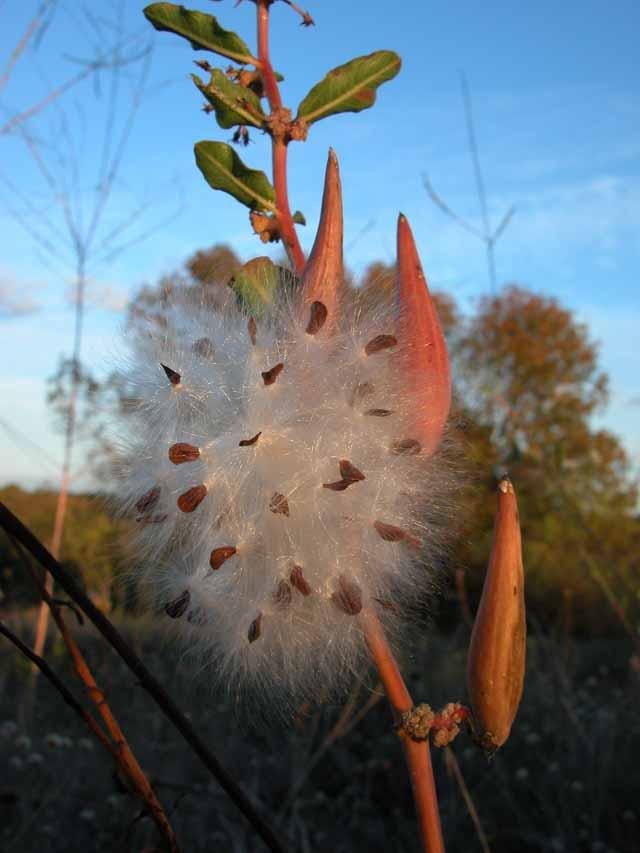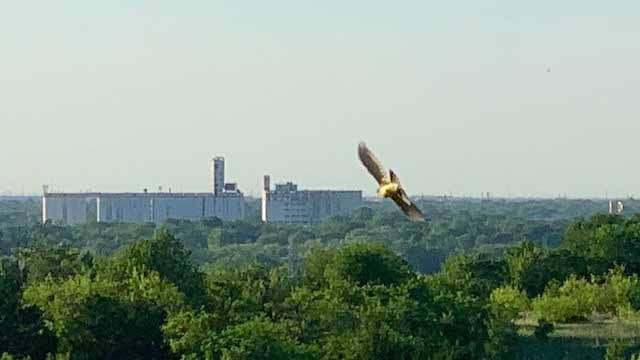Prairie Notes #163 - The Acrobatic Swallows of Tandy Hills
Prairie Notes are monthly photo/journal observations from Tandy Hills Natural Area by Founder/Director, Don Young. They include field reports, flora and fauna sightings, and more, mixed with a scoop of dry humor and a bit of philosophy.
They are available free to all who get on the FOTHNA email list.
The Acrobatic Swallows of Tandy Hills
Prairie Notes #163
July 1, 2020
01) The Acrobatic Swallows of Tandy Hills
02) Field Report - June
03) Kids & Family Nature Fun (Indoors & Out)
04) New Species - June
05) Dragonfly Summer
06) Broadcast Hill Celebration & More
07) PrairieSky / StarParty News
08) Prairie Bookshelf
09) Prairie Proverb - William Shakespeare
01) The Acrobatic Swallows of Tandy Hills
Picture in your mind the starfighter scenes in the first Star Wars movie. Imagine the Rebel Alliance X-Wings dueling it out with the Empire's TIE fighters. Recall the dizzying speed and gravity-defying, vertigo-inducing maneuvering and you get an idea of what Barn Swallows do for a living. This battle is between Swallows and their inscet prey which feeds their voracious appetite.
Recorded only recently on iNaturalist, the Barn Swallow (Hirundo rustica) is a marvel of avian engineering, skill and apparent joy. Their blade-like wings cut through the air with breathtaking aerodynamic efficiency. The wide open meadows along View Street, filled with low-growing native wildflowers and vast numbers of insects, are ideal habitat for Barn Swallows who have adapted well to living in close proximity to humans. The electric wires strung along the street are useful for these perching birds who need breaks between frenetic feeding sprints.
According to Tom Stevens, 2007 seminal bird survey of Tandy Hills <LINK>, these migratory marvels usually show up here in April and hang out until September. There have been three species of birds in the Swallow family recorded at Tandy Hills: Purple Martin, Northern Rough-winged Swallow and the more common Barn Swallow which is the most widespread species of swallow in the world. They typically build their nests in man-made structures from mud pellets, often under eaves. I've yet to find a nest but they must be nearby.
The word "common" applies only to their numbers and range. They are, in fact, anything but. These beautiful birds are about 7" long with a 13" wingspan. Their most distinctive feature is a deeply cut, "swallow-tail". They have steel blue upperparts and a reddish-brown forehead, chin, throat and breast band. The upper tail has a row of white spots which pop out in certain conditions. (Before I started paying closer attention, I confused them with Eastern Bluebirds who hang out on the same wires and because of their blue color.)
Due to their mostly good realtionships with humans as insect predators, they have been the subject of poets, writers and artists. Shakespeare cited them in several of his plays. One exception, however, was the slaughter of Barn Swallows for their feathers in the Victorian era for women's hat-decorating that prompted an editorial by naturalist, George Bird Grinnell to write his famous editorial in 1886 opposing the practice. That editorial led to the formation of the Audubon Society. They are also one of the most widely depicted birds on international postage stamps, as you can see HERE.
The poet, Robinson Jeffers, once wrote, "Give your heart to the Hawks." I say: Spend a summer morning watching the joyous, acrobatic foraging of the Swallows of Tandy Hills and you may feel an urge to "Give your heart and soul to the Swallows."
DY
02) Field Report - June
There was a lot going on at Tandy Hills in June. Every time I ventured out something amazing crossed my path or caught my eye. Here's a virtual walking tour in my hiking boots:
03) Kids & Family Nature Fun
Michael Smith's, Treefrog Times is a wonderful way to engage kids during thes crazy times. Check out the latest issue here: https://jsdragons.files.wordpress.com/2020/06/treefrog-times-jun2020.pdf
04) New Species - June
Ten new species were recorded in the month of June. Heavy rains followed by hot dry days contributed to a bunch of new fungi species. In addition to the fungi, two new Dragonfly species, a critilcally imperiled bee and the above mentioned, Barn Swallow were newly recorded. The new total as of June 30 is, 1352. Check out the iNat website here: https://www.inaturalist.org/projects/tandy-hills-natural-area-stratford-...
Here is the full list for June along with a few standout examples:
- Barn Swallow (Hirundo rustica), DY
- Checkered Setwing Dragonfly (Dythemis fugax), DY
- Chocolate Tube Slimes, pynklynx
- Coprinellus Sect. Domestici, pynklynx
- Eastern Ringtail Dragonfly (Erpetogomphus designatus), pynklynx
- Genus Hypomyces, pynklynx
- Genus Lycogala, pynklynx
- Honeycomb Coral Slime Mold, pynklynx
- Order Stemonitales, pynklynx
- Robust Sunflower Leafcutter Bee (Megachile fortis), DY
- True Slime Mold (Family Arcyriaceae), pynklynx
- Twirler Moth (Subfamily Anomologinae) DY
05) Dragonfly Summer
Swallows aren't the only critter devouring insects in dizzying maneuvers above the Tandy Hills meadows. Dragonflies of several beautiful species are on the job all summer long, gobbling mosquitoes, flies and other hapless insects. Check out this short video of a June frenzy.
https://www.youtube.com/watch?v=totOgHdiR0U&fbclid=IwAR18T_WMMCpJl3fGFio...
06) Broadcast Hill Celebration & More
We have traveled a long road from 2004 when Friends of Tandy Hills formed as a reaction to industrial development threats to Broadcast Hill and Tandy Hills. But in June 2020 an historic destination was reached for Friends of Tandy Hills. The Friends group were honored by Fort Worth City Council as we presented a big check on June 16, to help pay for the 52 acres that the city just purchased. (In a delicious bit of irony, Chesapeake Energy, the compnay that bought the land in 2006 with intentions to drill for natural gas, filed for bankruptsy this week.)
We had originally planned a celebration for Earth Day 2020, but a pandemic and other factors put the kabosh on that. So on June 25, the City of Fort Worth and FOTHNA hosted a celebration of the official opening of the new natural area. Inspired speeches were given in the middle of a beautiful 250-acre carbon sink by, Fort Worth Asst City Manager and event emcee, Dana Burghdoff, District 8 Council-member, Kelly Allen Gray, Director of the FW Nature Center & Refuge (retired), Suzanne Tuttle, FOTHNA member, Jim Marshall, Texas Parks & Wildlife Urban Wildlife Biologist, Sam Kieschnick and FOTHNA President, Don Young.
MELT ice cream was served, a bluegrass band played and walking tours were led by the experts. As Jim Marshall said, "It was a great day for Fort Worth." It was also a great day for planet Earth, as well. Come on in to your new natural area.
Resources:
- FW Star-Telegram report by new environmental reporter, Haley Samsel: https://www.star-telegram.com/news/local/fort-worth/article243824967.html
- GreenSource DFW report by, John Kent: https://www.greensourcedfw.org/articles/nature-officially-reclaims-fort-...
- Video of Broadcast Hill celebration by Philip Hennen (23 minutes): https://www.youtube.com/watch?v=PlUzzt8dQoA&fbclid=IwAR2FVhKp4bIk1kwmtKu...
- City of Fort Worth website report: https://fortworthtexas.gov/news/2020/06/Broadcast-Hill-Purchase-Finalize...
07) PrairieSky / StarParty News
It's not looking good for star parties in the foreseeable future but, Pam Kloepfer of the Fort Worth Astronomical Society has provided you with home-bound stargazing info for July:
"There are lots of constellations and stars to observe in the summer sky just by “looking up” or with a pair of binoculars. Look in the south for the ruddy red star Antares, the alpha star of the large constellation Scorpius the Scorpion. Let your eyes adjust and see if you can discern three outwardly projecting stars to the west. That is the scorpion’s claw. Watch for the Summer Triangle. Look for bright star Vega overhead, Deneb to the NE and Altair to the south. They will make an isosceles triangle. The Big Dipper with its handle pointing to Arcturus, then Spica make a tight fit across the sky early in the month. The planets are rising! Jupiter and Saturn will rise earlier each night as the month proceeds. Jupiter will be very bright and might appear reddish low in the southeastern sky from the turbulence of our atmosphere. The Moon will be full on July 5! Watch for it to then emerge waning in the morning sky in the west."
08) Prairie Bookshelf
Aldo Leopold, was a giant among nature writers and thinkers. His influential masterpiece, A Sand County Almanac, originally published in 1949, was republished in May 2020 with a new introduction by, Barbara Kingslover. Check it out here:
https://global.oup.com/academic/product/a-sand-county-almanac-9780197500...
08) Prairie Proverb
“True hope is swift, and flies with swallow’s wings”
Prairie Notes© is the official newsletter of Friends of Tandy Hills Natural Area, a 501 (c)(3) non-profit organization. All content by Don Young except where otherwise noted.

















































